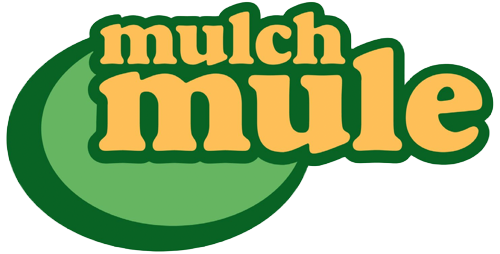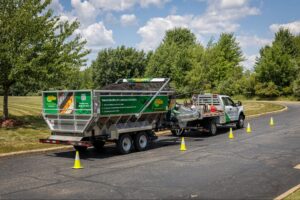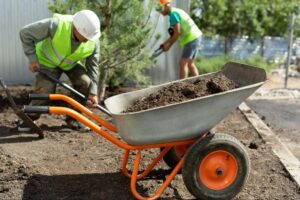In a competitive industry like landscaping, controlling costs is paramount to staying profitable. As businesses prepare for the future, rising expenses related to materials, labor, and equipment will continue to challenge landscapers of all sizes. To overcome these obstacles, businesses need robust landscaping cost control strategies that prioritize efficiency, safety, and long-term profitability.
This article delves into proven methods to manage costs effectively while maintaining quality and employee satisfaction. We’ll explore the critical roles that innovation, strategic investments, and workforce optimization play in driving operational success. From adopting versatile year-round equipment to building a safety-first culture, every tactic discussed is designed to help you balance daily operations with future growth.
Whether you’re managing a small crew maintaining community properties or a larger team handling municipal projects, the insights outlined here will help you address current challenges and adapt to emerging trends. By implementing these strategies, you can position your business for a successful and profitable year ahead while solidifying your reputation as a trusted service provider in the landscaping industry. Let’s start by examining how strategic planning lays the groundwork for effective cost control.
Strategic Planning: Building the Foundation for Cost Control

Effective cost management in landscaping starts with a solid strategic plan. This means setting clear financial objectives for each season and mapping out anticipated expenses such as labor, materials, equipment, and overhead. By analyzing these costs and understanding how they fluctuate throughout the year, you can make informed decisions and adjust your operations accordingly. A proactive approach ensures you are prepared for seasonal changes and minimizes the risk of unexpected financial strain.
Key to successful planning is utilizing modern tools that offer detailed insights into project costs and resource allocation. These tools allow you to see the true profitability of individual projects and enable data-backed decision-making related to pricing, scheduling, or staffing. With clear visibility into your operations, you can pinpoint areas where costs can be reduced without sacrificing quality.
Additionally, forecasting plays a crucial role in preparing for the challenges and opportunities of landscaping. With continual changes in resource costs, labor availability, and market demands, building contingencies into your pricing and plans is essential. Over-dependence on historical data without accounting for future market trends may lead to profit declines. Stay ahead by aligning your strategy with current industry conditions, market forecasts, and your long-term business goals. Effective cost forecasting is a vital part of this process.
Strategic planning not only safeguards your bottom line but also positions your company to thrive despite the unpredictability of the industry. The combination of detailed budgeting, smart forecasting, and data-driven decision-making creates a robust foundation for effective cost control and operational success.
Workforce Optimization: Enhancing Productivity While Reducing Costs
Labor is one of the most significant expenses in landscaping, making workforce optimization a crucial cost-control strategy. By streamlining workflows and leveraging the right tools, landscaping companies can maximize efficiency while minimizing unnecessary labor costs. This means shifting away from outdated manual approaches and embracing methods that allow crews to work smarter, not harder.
One effective approach is integrating equipment that automates tasks such as material handling and distribution, thereby freeing up workers to focus on tasks that require their specialized skills. As a result, overall project timelines are reduced and productivity improves, enabling crews to accomplish more with a leaner labor force.
Ongoing training and skill development play a critical role in workforce optimization. Employees who are well-trained not only perform tasks faster and with greater accuracy but also feel more engaged and valued. This translates to higher job satisfaction and reduced turnover—an important consideration for an industry often faced with labor shortages. Retaining skilled workers saves time and money on recruitment efforts and ensures consistent, high-quality results for clients.
Workforce optimization is also about creating a safer and more supportive work environment. By mitigating worker fatigue and injury risks through efficient operations, businesses can protect employees while maintaining cost-effective practices. Ultimately, these measures allow landscaping companies to control labor expenses while delivering excellent service—benefiting both operations and team morale.
Equipment Investment: Making Smart Purchases for Long-Term Savings
Investing in the right equipment is a cornerstone of effective cost control in landscaping. To maximize long-term savings, businesses need to prioritize tools that excel in functionality, versatility, and durability. Choosing multi-purpose landscaping equipment that can handle a variety of tasks across different projects not only improves efficiency but also reduces the need for seasonal rentals or multiple single-purpose machines. For example, an advanced trailer equipped with a quick-discharge system and multipurpose attachments can help consolidate tasks such as distributing mulch, hauling debris, and handling soil, thereby reducing the dependency on manual labor.
A critical component of equipment investment is evaluating the return on investment. The most valuable tools are those that streamline processes, reduce labor demands, and enhance jobsite efficiency. Equipment that automates material handling can significantly shorten task durations and improve operational workflow. Additionally, opting for versatile year-round landscaping equipment means you can manage tasks from spring mulching to fall cleanup—leading to considerable long-term cost savings.
Boosting Safety and Minimizing Workman’s Compensation Costs

Safety is a cornerstone of effective cost control in landscaping, not only for protecting employees but also for minimizing financial losses associated with workplace injuries. Employee injuries can lead to costly medical expenses, increased workman’s compensation claims, and interruptions in project timelines—all of which affect profitability. A proactive approach to safety prevents these setbacks and reinforces a culture where employee well-being is paramount.
Establishing this culture begins with regular safety discussions and clear protocols that help employees recognize and avoid hazards on the job. Encouraging open communication and feedback fosters an environment where potential risks are quickly addressed, ultimately leading to fewer injuries, lower insurance costs, and more reliable project execution.
Sustainability and Eco-Friendly Cost Control Measures
Sustainability is not just an ethical consideration in the landscaping industry—it’s a smart cost-control strategy that can strengthen your bottom line and enhance your reputation. By embracing environmentally responsible practices, companies can reduce costs while appealing to clients who value eco-friendly operations. One method is recycling and repurposing organic materials. Instead of paying for disposal, materials such as grass clippings and leaves can be transformed into mulch or compost, thereby reducing disposal expenses.
Adopting energy-efficient operations also helps manage costs over time. Reducing energy usage in facilities and on the jobsite can lead to substantial savings and bolster your brand image. By aligning both environmental responsibility and cost-control initiatives, you can enhance profitability while positioning your business as a leader in sustainable landscaping practices.
The Financial Benefits of Time-Saving Innovations
In the landscaping industry, time is one of the most valuable resources, and saving it can have a direct impact on your bottom line. Lengthy, labor-intensive tasks not only strain the workforce but also drive up operational costs. By adopting time-saving innovations, you can streamline processes, complete projects faster, and increase overall productivity without sacrificing quality.
For instance, advanced equipment with automated discharge systems minimizes the need for prolonged manual handling. Features like remote controls reduce errors and eliminate the need for re-work, enabling your team to meet deadlines more effectively while lowering overall labor expenses. The net effect is a more nimble operation capable of handling more projects and generating increased revenues.
Customer Service and Reputation as Indirect Cost Control Strategies
Delivering exceptional customer service and nurturing a solid reputation serve as powerful indirect methods of cost control. Satisfied customers are more likely to become repeat clients and provide referrals, which can reduce the need for extensive marketing efforts. Clear communication, professionalism, and reliable service help build long-term trust with your clients, ensuring loyalty despite market fluctuations.
Prioritizing excellent customer service cultivates strong client relationships, which can prove resilient in the face of seasonal shifts and competitive pressures. Positive word-of-mouth referrals, combined with dependable service, may significantly lower your customer acquisition costs over time.
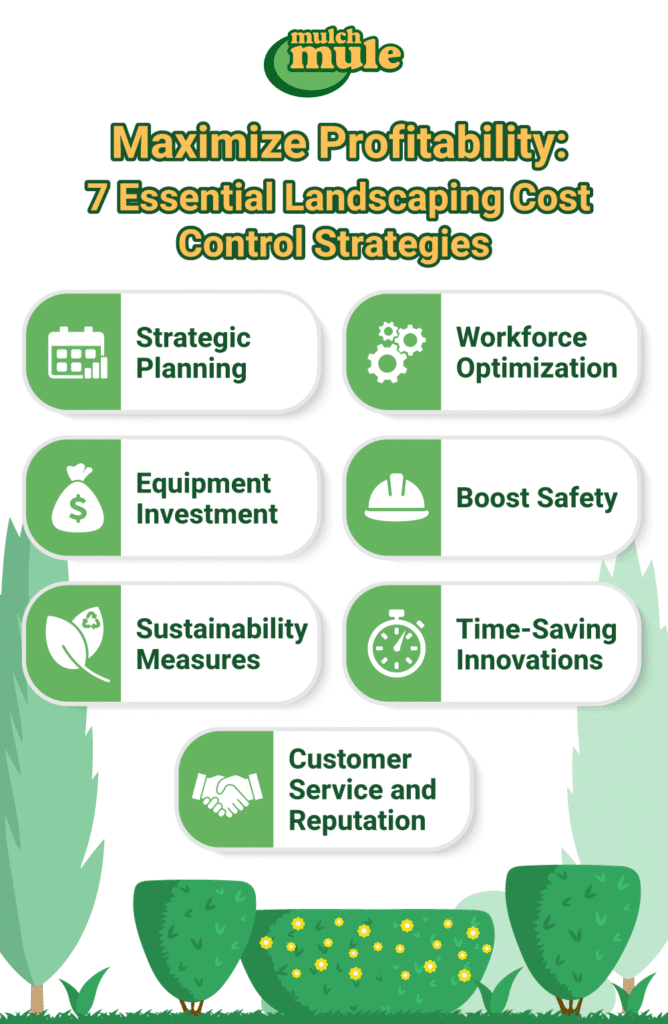
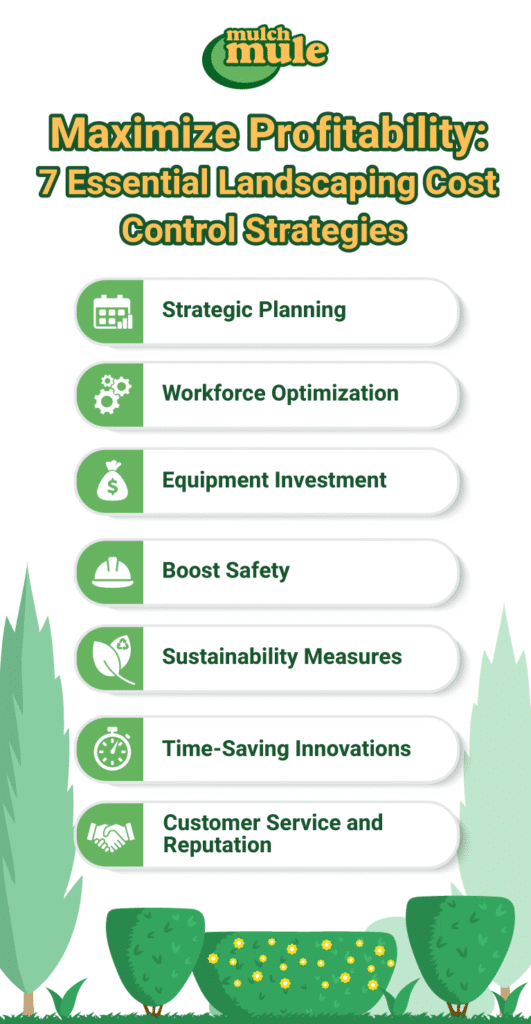
A Practical Case Study Example—Minards Landscape and Design
Consider one example where a landscaping business, challenged by labor-intensive tasks and seasonal fluctuations, sought solutions to streamline operations. Instead of relying solely on manual methods for hauling materials, the business invested in advanced equipment—a trailer equipped with an efficient discharge system and versatile attachments. By enabling faster loading and unloading, the equipment allowed tasks previously requiring larger crews to be managed by fewer team members. Over time, these enhancements helped the business lower labor expenses, freeing up resources that were then redirected toward employee safety training and operational improvements. In addition, the equipment’s functionality throughout the year supported the business in securing off-season contracts, thereby diversifying revenue streams and enhancing overall resilience.
Click the video below to hear Keegan Minard, the owner of Minards Landscape, talk about his experience starting out in the landscape design industry and how the Mulch Mule has helped him.
Put These Cost-Control Strategies Into Action
Mastering cost control in landscaping requires a balanced strategy that encompasses detailed planning, workforce optimization, and judicious equipment investments. By forecasting trends, streamlining operations, and embracing innovative, sustainable tools, you can effectively manage expenses without compromising on quality.
It is critical to explore solutions that address labor-intensive challenges and boost operational efficiency — not only to cut costs but also to build a safer, more sustainable business model. By adopting these cost-control strategies, you can position your business for a future that is both profitable and resilient in a competitive industry. Reach out to the experts at Mulch Mule today to learn how this innovative trailer can increase productivity without having to increase your labor costs.
